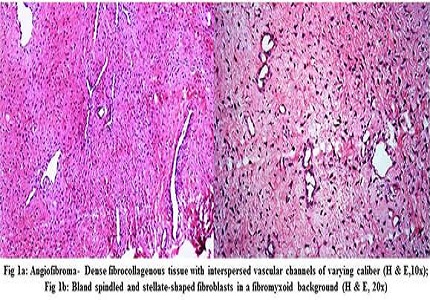Clinico-pathological study of benign soft tissue tumors: a study from tertiary teaching hospital
Abstract
Background: Aim of the study was to analyze the histopathological findings in various benign soft tissue tumors and to study its frequency distribution in relation to age, gender and anatomical site.
Material and Method: Total of 250 cases of soft tissue lesions were analyzed retrospectively and prospectively in a period 2.5 years during June 2009 to Dec 2011. In addition to routine Haematoxylin and Eosin stained sections of all the specimens, special stains with immunohistochemical markers were done wherever necessary. Age and sex incidence, site of lesion, clinical features, gross and microscopic appearance were carefully studied.
Result: Of 250 lesions analyzed, 213 (185.2%) were benign soft tissue tumors. Overall a male predominance was seen with 57.4% in males. Majority of the benign tumors occurred in third decade (21%). The most common site of occurrence was head and neck (38%). On gross examination 160(75%) cases measured less than 5cms. Lipoma was the most common benign soft tissue tumor (68 cases, 31.9%) followed by capillary hemangioma (28 cases, 13.1%).
Conclusion: The large majority of soft tissue tumors are benign with a very high cure rate after surgical excision. Aggressive benign myxoid soft tissue tumors require wide surgical excision and close follow up. The diagnosis and management of benign soft tissue tumors require a team perspective consisting of clinical, radiological and pathological correlation.
Downloads
References
2. Randall RL. Approach to the diagnosis of bone and soft tissue tumors – Clinical, radiologic, and classification aspects. In: Folpe AL, Inwards CY, editors. Bone and Soft Tissue Pathology. 1st ed. Philadelphia: Saunders/Elsevier Publishing; 2010.
3. Rydholm A. Management of patients with soft-tissue tumors. Strategy developed at a regional oncology center. Acta Orthop Scand Suppl. 1983;203:13-77. [PubMed]
4. Rydholm A, Berg NO, Gullberg B et al. Epidemiology of soft tissue sarcoma in the locomotor system: A retrospective population based study of the inter-relationships between clinical and morphologic variables. ActaPathol Microbial Immunol Scand. 1984;92:363-74.
5. Agravat AH, Dhruva GA, Parmar SA. Histopathology study of human’s soft tissue tumours and tumour like lesions. J Cell Tissue Research. 2010;10(2):2287-92.
6. Ramnani BG, Kumar A, Chandak S, Ranjan A, Patel MK. Clinicopathological profile of benign soft tissue tumours: a study in a tertiary care hospital in Western India. J Clin Diagn Res. 2014 Oct;8(10):FC01-4. doi: 10.7860/JCDR/2014/8690.4918. Epub 2014 Oct 20. [PubMed]
7. Rosenberg AE. Bones, joints and soft tissue tumors. In: Kumar V, Abbas AK, Fausto N, Aster JC, editors. Robbins and Cotran Pathologic Basis of Disease. 8th ed. Philadelphia: Elsevier; 2010.
8. Allen PW. The diagnosis, classification and grading of soft tissue tumors. J Orthop Sci.1996;1:148-56.
9. Fletcher C.D.M., Unni K.K., Mertens F. (Eds.): World Health Organization Classification of Tumors. Pathology and genetics of tumors of soft tissue and bone. IARC Press:Lyon 2002.
10. Kura MM, Jindal SR, Khemani UN. Aggressive angiomyxoma of the vulva: An uncommon entity. Indian Dermatol Online J. 2012 May;3(2):128-30. doi: 10.4103/2229-5178.96712. [PubMed]
11. Myhre-Jensen O. A consecutive 7-year series of 1331 benign soft tissue tumours. Clinicopathologic data. Comparison with sarcomas. Acta Orthop Scand. 1981 Jun;52(3):287-93. [PubMed]
12. Dev G, Banerjee AK, Aikat BK. Soft tissue tumours. I. Benign tumours. Indian J Cancer. 1974 Sep;11(3):336-43. [PubMed]
13. Kransdorf MJ. Benign soft-tissue tumors in a large referral population: Distribution of specific diagnosis by age, sex and location. AJR. 1995;164:395-402.
14. Jingping, Zhang, Chunfu Z. Clinical Experiences on Aggressive Angiomyxoma in China (Report of 93 Cases). International Journal of Gynecological Cancer. 2010;20(2):303-07.



 OAI - Open Archives Initiative
OAI - Open Archives Initiative


